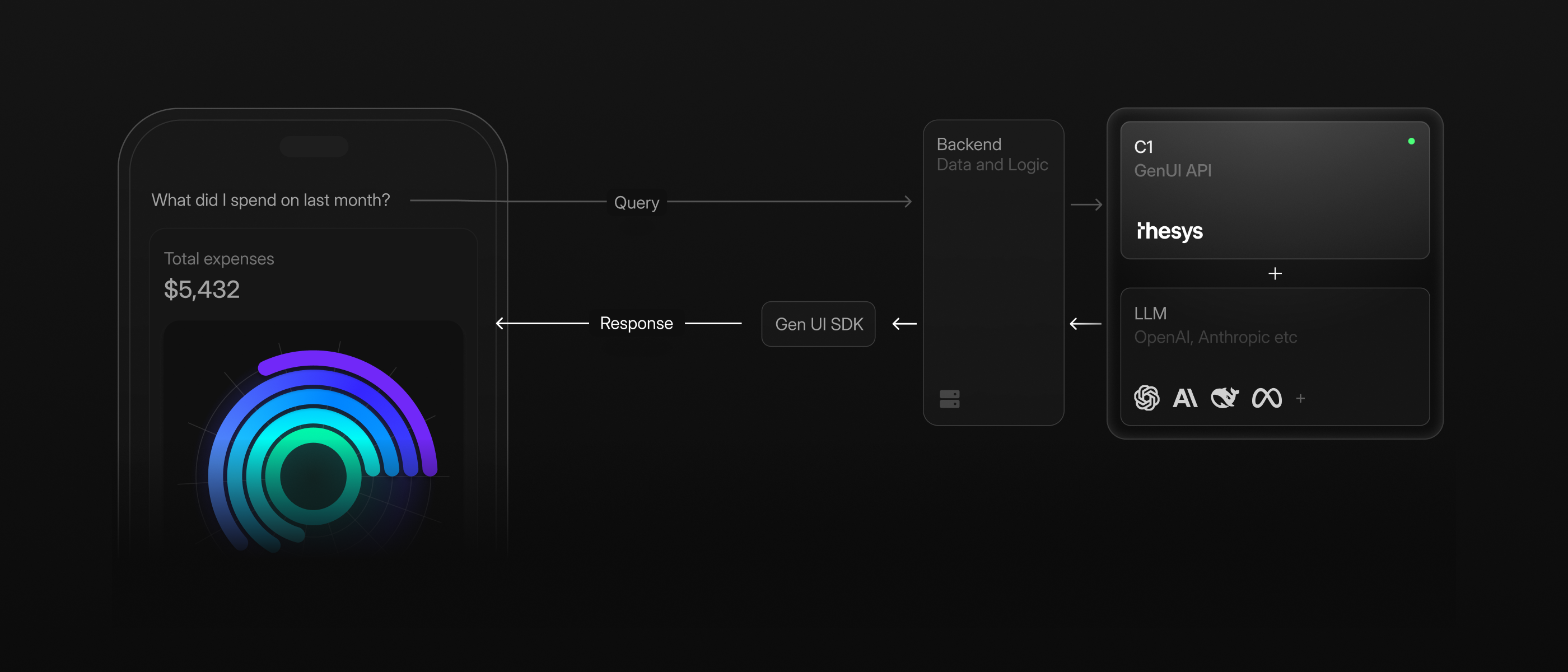As generative AI is reshaping the entire user experience of how software is built and used, developers are constantly seeking new types of infrastructure platforms—ones that will make it seamless to build, manage, and even scale intelligent applications.
Thesys was founded to meet this moment. Thesys’s mission is to make generative UIs (interfaces that dynamically adapt to the user) accessible and put them in the hands of every developer.
Behind the scenes, MongoDB Atlas serves as the backbone of Thesys’s platform, powering everything from authentication and billing to API management with unparalleled flexibility and reliability.
In the era of AI-driven interfaces, MongoDB is providing Thesys with the foundation to thrive.
What Generative UI is
A generative UI is a UI that is dynamically created in real time to adapt to a user’s needs, context, and goals. Instead of showing every user the exact same static screen, a generative UI continuously reshapes itself–changing out components, surfacing insights, and even helping simplify workflows on the fly. While traditional interfaces are one-size-fits-all, generative interfaces are custom-tailored to the specific needs of the user.
Unlike AI-assisted design or development tools that help designers and developers create prototypes or mockups, generative UIs focus on the end-user experience. It’s not about designing faster; it’s about making the interface itself intelligent so it can understand user intent and respond visually, not just textually.

Why Generative UI matters
Even as AI models become trained on more data and, in turn, become smarter, most applications remain trapped behind static chat bubbles or dashboards. Developers hardcode countless screens, while users sift through text to find what truly matters. The mismatch? AI that understands you but can’t show you. This gap kills engagement and can slow iteration—factors that are crucial for user productivity. Teams spend time rebuilding UI layers for each use case rather than focusing on the holistic experience itself.
Generative UIs bridge this gap by making AI interfaces adaptive, expressive, and instantly usable, and as a result, they unlock a new frontier in human-computer interaction.
How Thesys solves generative UIs’ hard problems
Building a generative UI platform from scratch is incredibly complex. Developers have to orchestrate model parsing, real-time rendering, system design, and data synchronization, challenges that can quickly become unscalable.
Thesys simplifies this process with C1, an API middleware that sits between your large language model (LLM) and frontend. C1 transforms text-based model outputs into live, adaptive UIs in real time.
C1 acts as an intelligent UI layer that operates through a seamless flow:
It understands the context of user interactions.
It generates a UI dynamically using composable components based on that context.
It renders the resulting interface on your frontend.
Developers can simply call the Thesys C1 API (which is compatible with any LLM, framework, or model context protocol server), and the system handles all the complexity behind the scenes.
In short? Thesys abstracts away the complexities of generative UIs, enabling teams to ship AI-native, context-aware interfaces effortlessly.

Why MongoDB is a catalyst for innovation
Under the hood, Thesys’s platform relies on MongoDB Atlas to fully manage its operational backbone. From user accounts and API keys to billing and access management, every operation is backed by MongoDB Atlas—a data layer that is fully optimized for flexibility and performance.
MongoDB’s document model means Thesys can store related entities, such as users and usage data, within the same documents, enabling critical data to coexist naturally and simplifying operations for Thesys’s engineering team. This, in turn, streamlines queries and simplifies code. As the platform scales in the hands of users, this architecture ensures consistent speed and reliability for Thesys’s user base.
Thesys’s operational data is constantly evolving, with new metadata and features emerging weekly, but MongoDB’s flexible schema provides Thesys with the freedom to adapt instantly without painful migrations or rigid table definitions.
In a fast-evolving environment, this adaptability is crucial. “For a startup like Thesys, speed of execution means everything. MongoDB helps us move fast in an ever-changing world,” said Rabi Shanker Guha, Cofounder and CEO of Thesys. “The best database is the one you don’t have to think about—it just works exactly where and how you need it. That’s MongoDB for us.”
By managing backend operations seamlessly, MongoDB enables Thesys to stay focused on empowering developers to build dynamic interfaces without distractions.
How MongoDB for Startups helped
Thesys’s journey was accelerated through the MongoDB for Startups program, which provides founders with MongoDB Atlas credits, hands-on technical help, and access to various go-to-market opportunities. The program empowers emerging AI and infra startups to scale quickly and securely—just like Thesys.
What to expect ahead
As Thesys continues to expand globally, its use of MongoDB Atlas will enable its next phase of growth: supporting new analytics, usage insights, and developer-facing capabilities. Flexible, schema-less storage means that as Thesys evolves, its data layer evolves alongside it.
For a startup like Thesys, speed of execution means everything. MongoDB helps us move fast in an ever-changing world. The best database is the one you don’t have to think about—it just works exactly where and how you need it. That’s MongoDB for us.
”Next Steps
Learn more and apply today on our MongoDB for Startups page.
Check out Thesys.